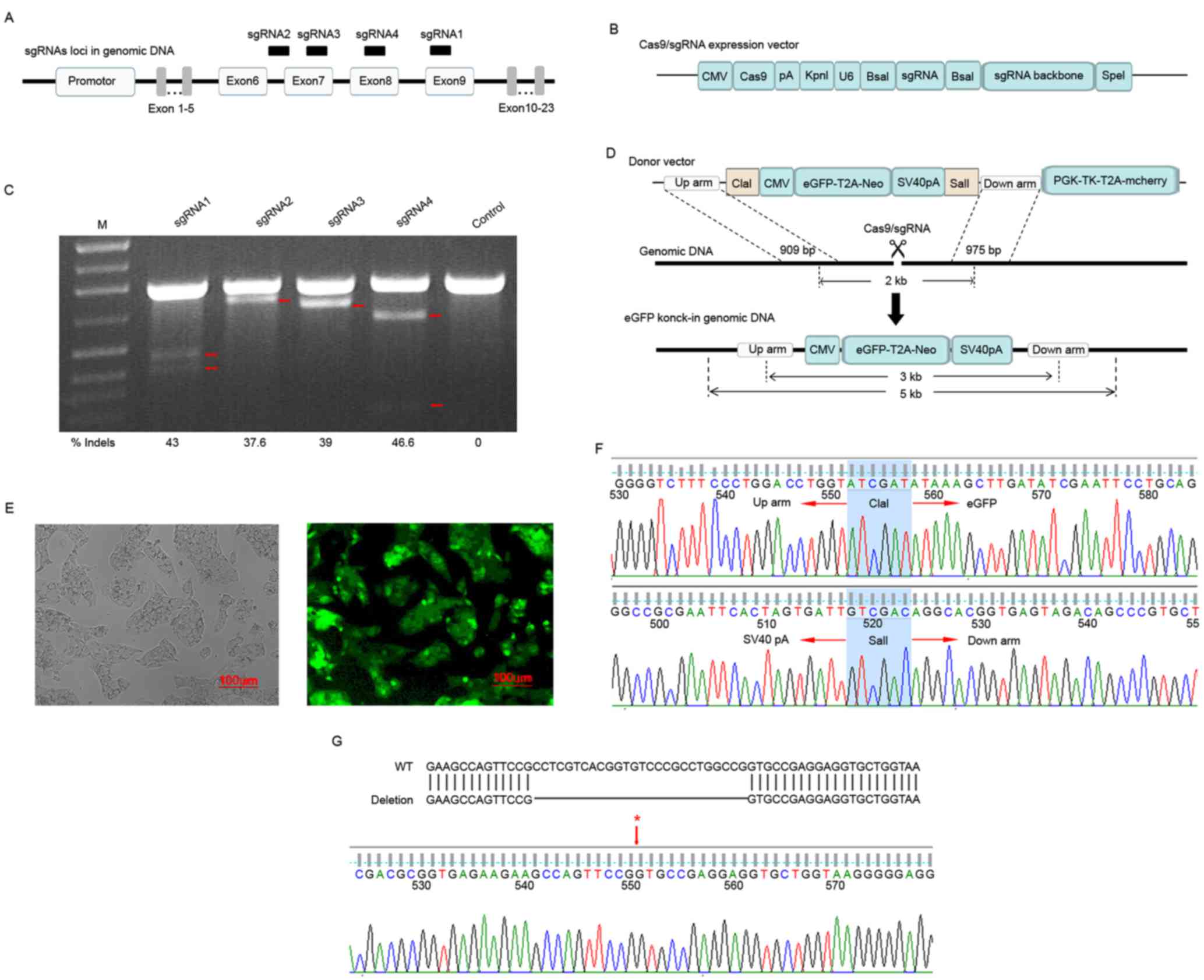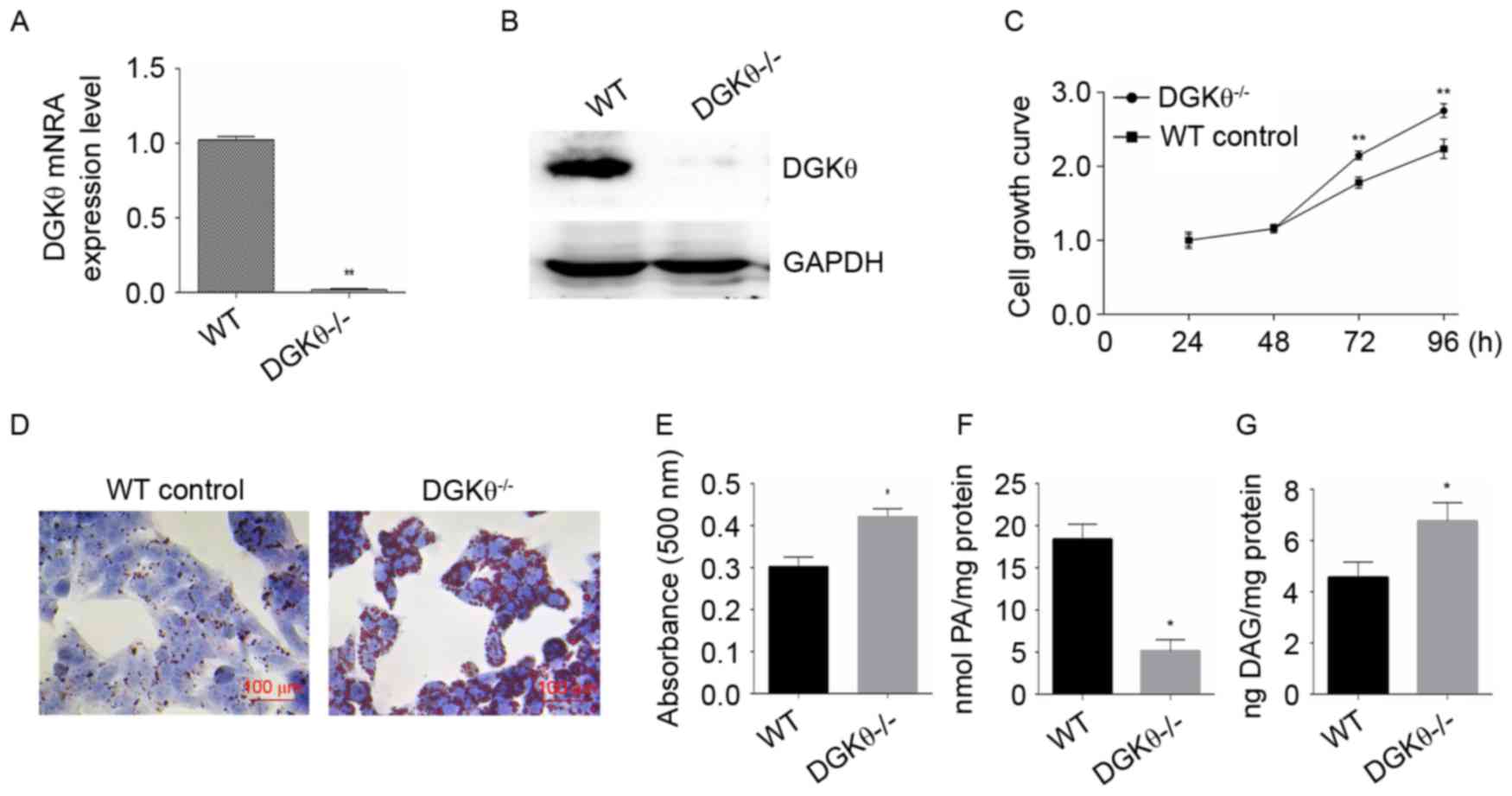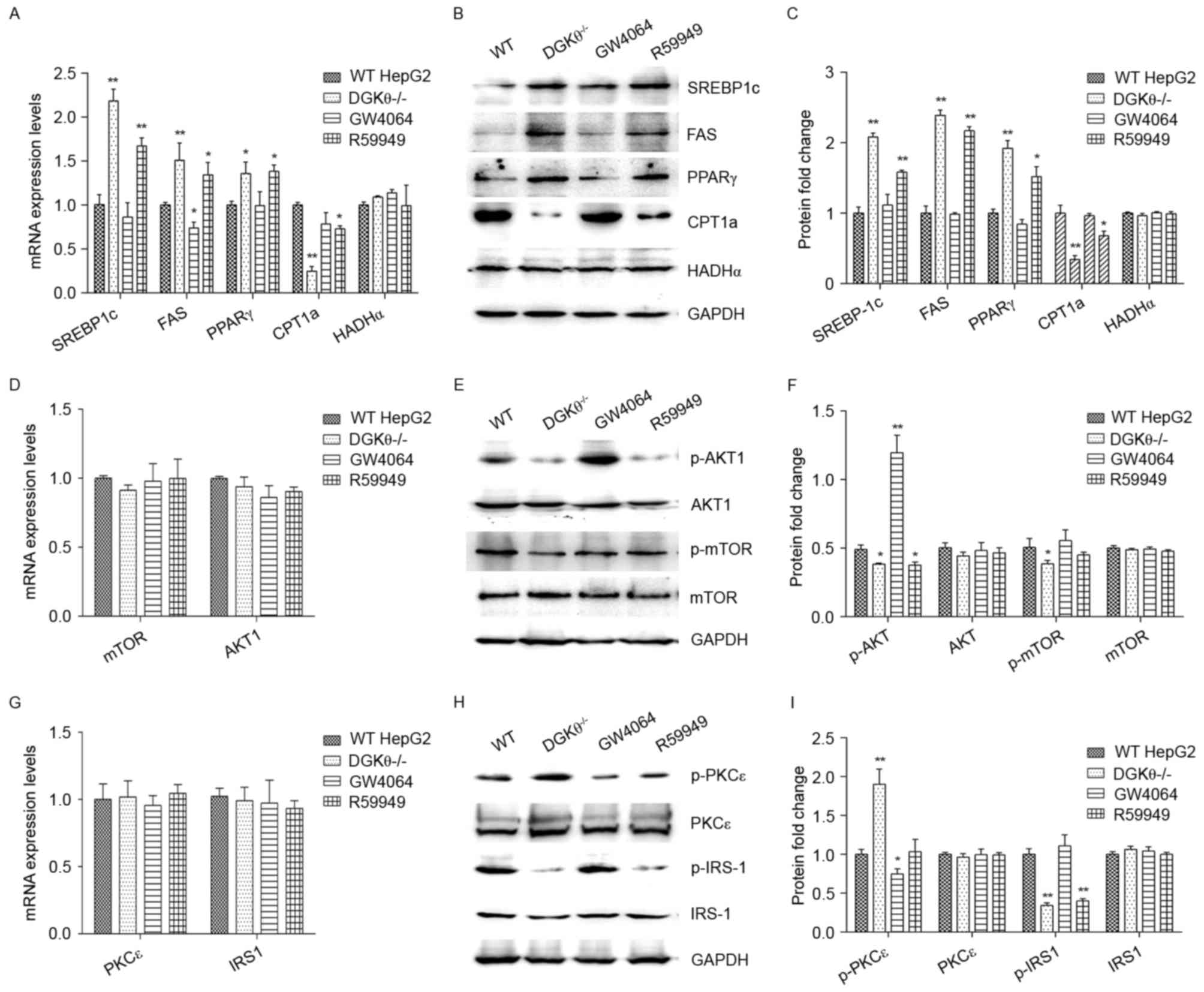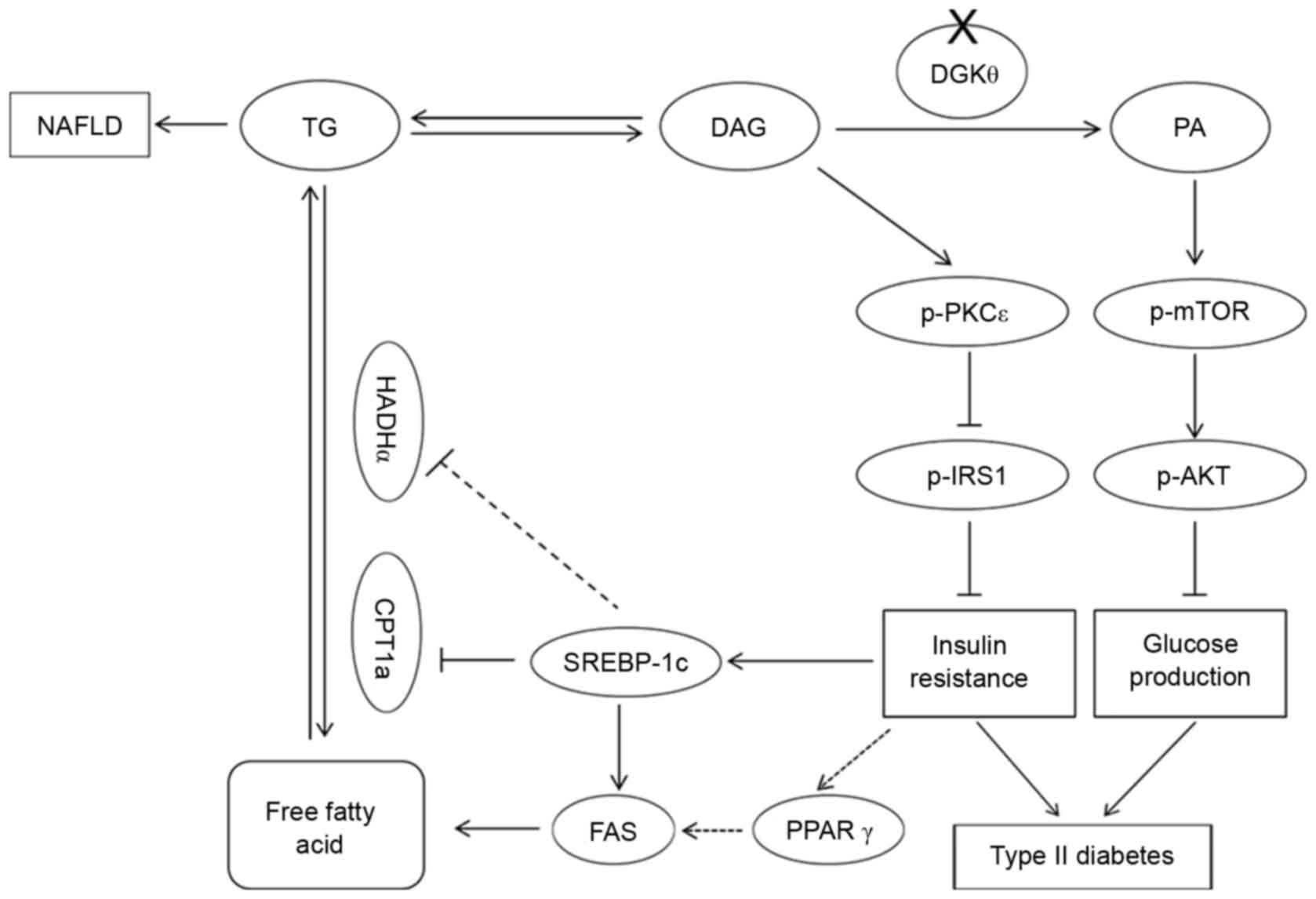|
1
|
Cai J, Abramovici H, Gee SH and Topham MK:
Diacylglycerol kinases as sources of phosphatidic acid. Biochim
Biophys Acta. 1791:942–948. 2009. View Article : Google Scholar : PubMed/NCBI
|
|
2
|
Griner EM and Kazanietz MG: Protein kinase
C and other diacylglycerol effectors in cancer. Nat Rev Cancer.
7:281–294. 2007. View
Article : Google Scholar : PubMed/NCBI
|
|
3
|
Mérida I, Avila-Flores A and Merino E:
Diacylglycerol kinases: At the hub of cell signaling. Biochem J.
409:1–18. 2008. View Article : Google Scholar : PubMed/NCBI
|
|
4
|
Houssa B, Schaap D, van der Wal J, Goto K,
Kondo H, Yamakawa A, Shibata M, Takenawa T and van Blitterswijk WJ:
Cloning of a novel human diacylglycerol kinase (DGKtheta)
containing three cysteine-rich domains, a proline-rich region, and
a pleckstrin homology domain with an overlapping Ras-associating
domain. J Biol Chem. 272:10422–10428. 1997. View Article : Google Scholar : PubMed/NCBI
|
|
5
|
Su AI, Wiltshire T, Batalov S, Lapp H,
Ching KA, Block D, Zhang J, Soden R, Hayakawa M, Kreiman G, et al:
A gene atlas of the mouse and human protein-encoding
transcriptomes. Proc Natl Acad Sci USA. 101:pp. 6062–6067. 2004;
View Article : Google Scholar : PubMed/NCBI
|
|
6
|
Cantley JL, Yoshimura T, Camporez JP,
Zhang D, Jornayvaz FR, Kumashiro N, Guebre-Egziabher F, Jurczak MJ,
Kahn M, Guigni BA, et al: CGI-58 knockout sequesters
diacylglycerols in lipid droplets/ER-preventing
diacylglycerol-mediated hepatic insulin resistance. Proc Natl Acad
Sci USA. 110:pp. 1869–1874. 2013; View Article : Google Scholar : PubMed/NCBI
|
|
7
|
Samuel VT, Liu ZX, Qu X, Elder BD, Bilz S,
Befroy D, Romanelli AJ and Shulman GI: Mechanism of hepatic insulin
resistance in non-alcoholic fatty liver disease. J Biol Chem.
279:32345–32353. 2004. View Article : Google Scholar : PubMed/NCBI
|
|
8
|
Baldanzi G, Alchera E, Imarisio C,
Gaggianesi M, Dal Ponte C, Nitti M, Domenicotti C, van Blitterswijk
WJ, Albano E, Graziani A and Carini R: Negative regulation of
diacylglycerol kinase theta mediates adenosine-dependent hepatocyte
preconditioning. Cell Death Differ. 17:1059–1068. 2010. View Article : Google Scholar : PubMed/NCBI
|
|
9
|
Cai K and Sewer MB: cAMP-stimulated
transcription of DGKθ requires steroidogenic factor 1 and sterol
regulatory element binding protein 1. J Lipid Res. 54:2121–2132.
2013. View Article : Google Scholar : PubMed/NCBI
|
|
10
|
Chibalin AV, Leng Y, Vieira E, Krook A,
Björnholm M, Long YC, Kotova O, Zhong Z, Sakane F, Steiler T, et
al: Downregulation of diacylglycerol kinase delta contributes to
hyperglycemia-induced insulin resistance. Cell. 132:375–386. 2008.
View Article : Google Scholar : PubMed/NCBI
|
|
11
|
Birkenfeld AL and Shulman GI: Nonalcoholic
fatty liver disease, hepatic insulin resistance, and type 2
diabetes. Hepatology. 59:713–723. 2014. View Article : Google Scholar : PubMed/NCBI
|
|
12
|
Xiao D, Zhang W, Li Y, Liu K, Zhao J, Sun
X, Shan L, Mao Q and Xia H: A novel luciferase knock-in reporter
system for studying transcriptional regulation of the human Sox2
gene. J Biotechnol. 219:110–116. 2016. View Article : Google Scholar : PubMed/NCBI
|
|
13
|
Park JY, Kim Y, Im JA and Lee H: Oligonol
suppresses lipid accumulation and improves insulin resistance in a
palmitate-induced in HepG2 hepatocytes as a cellular steatosis
model. BMC Complement Altern Med. 15:1852015. View Article : Google Scholar : PubMed/NCBI
|
|
14
|
Livak KJ and Schmittgen TD: Analysis of
relative gene expression data using real-time quantitative PCR and
the 2(-Delta Delta C(T)) method. Methods. 25:402–408. 2001.
View Article : Google Scholar : PubMed/NCBI
|
|
15
|
Riordan SM, Heruth DP, Zhang LQ and Ye SQ:
Application of CRISPR/Cas9 for biomedical discoveries. Cell Biosci.
5:332015. View Article : Google Scholar : PubMed/NCBI
|
|
16
|
Wang X, Wang Y, Wu X, Wang J, Wang Y, Qiu
Z, Chang T, Huang H, Lin RJ and Yee JK: Unbiased detection of
off-target cleavage by CRISPR-Cas9 and TALENs using
integrase-defective lentiviral vectors. Nat Biotechnol. 33:175–178.
2015. View
Article : Google Scholar : PubMed/NCBI
|
|
17
|
Shalem O, Sanjana NE, Hartenian E, Shi X,
Scott DA, Mikkelson T, Heckl D, Ebert BL, Root DE, Doench JG and
Zhang F: Genome-scale CRISPR-Cas9 knockout screening in human
cells. Science. 343:84–87. 2014. View Article : Google Scholar : PubMed/NCBI
|
|
18
|
Cai K, Lucki NC and Sewer MB: Silencing
diacylglycerol kinase-theta expression reduces steroid hormone
biosynthesis and cholesterol metabolism in human adrenocortical
cells. Biochim Biophys Acta. 1841:552–562. 2014. View Article : Google Scholar : PubMed/NCBI
|
|
19
|
Zhao Y, Li H, Zhang Y, Li L, Fang R, Li Y,
Liu Q, Zhang W, Qiu L, Liu F, et al: Oncoprotein HBXIP modulates
abnormal lipid metabolism and growth of breast cancer cells by
activating the LXRs/SREBP-1c/FAS signaling cascade. Cancer Res.
76:4696–4707. 2016. View Article : Google Scholar : PubMed/NCBI
|
|
20
|
Ferré P and Foufelle F: SREBP-1c
transcription factor and lipid homeostasis: Clinical perspective.
Horm Res. 68:72–82. 2007.PubMed/NCBI
|
|
21
|
Lu M, Wan M, Leavens KF, Chu Q, Monks BR,
Fernandez S, Ahima RS, Ueki K, Kahn CR and Birnbaum MJ: Insulin
regulates liver metabolism in vivo in the absence of hepatic
Akt and Foxo1. Nat Med. 18:388–395. 2012. View Article : Google Scholar : PubMed/NCBI
|
|
22
|
Jacinto E, Facchinetti V, Liu D, Soto N,
Wei SY, Jung SY, Huang Q, Qin J and Su B: SIN1/MIP1 maintains
rictor-mTOR complex integrity and regulates Akt phosphorylation and
substrate specificity. Cell. 127:125–137. 2006. View Article : Google Scholar : PubMed/NCBI
|
|
23
|
Toschi A, Lee E, Xu L, Garcia A, Gadir N
and Foster DA: Regulation of mTORC1 and mTORC2 complex assembly by
phosphatidic acid: Competition with rapamycin. Mol Cell Biol.
29:1411–1420. 2009. View Article : Google Scholar : PubMed/NCBI
|
|
24
|
Cai K and Sewer MB: Diacylglycerol kinase
θ couples farnesoid X receptor-dependent bile acid signalling to
Akt activation and glucose homoeostasis in hepatocytes. Biochem J.
454:267–274. 2013. View Article : Google Scholar : PubMed/NCBI
|
|
25
|
Kumashiro N, Erion DM, Zhang D, Kahn M,
Beddow SA, Chu X, Still CD, Gerhard GS, Han X, Dziura J, et al:
Cellular mechanism of insulin resistance in nonalcoholic fatty
liver disease. Proc Natl Acad Sci USA. 108:pp. 16381–16385. 2011;
View Article : Google Scholar : PubMed/NCBI
|
|
26
|
Gual P, Le Marchand-Brustel Y and Tanti
JF: Positive and negative regulation of insulin signaling through
IRS-1 phosphorylation. Biochimie. 87:99–109. 2005. View Article : Google Scholar : PubMed/NCBI
|













